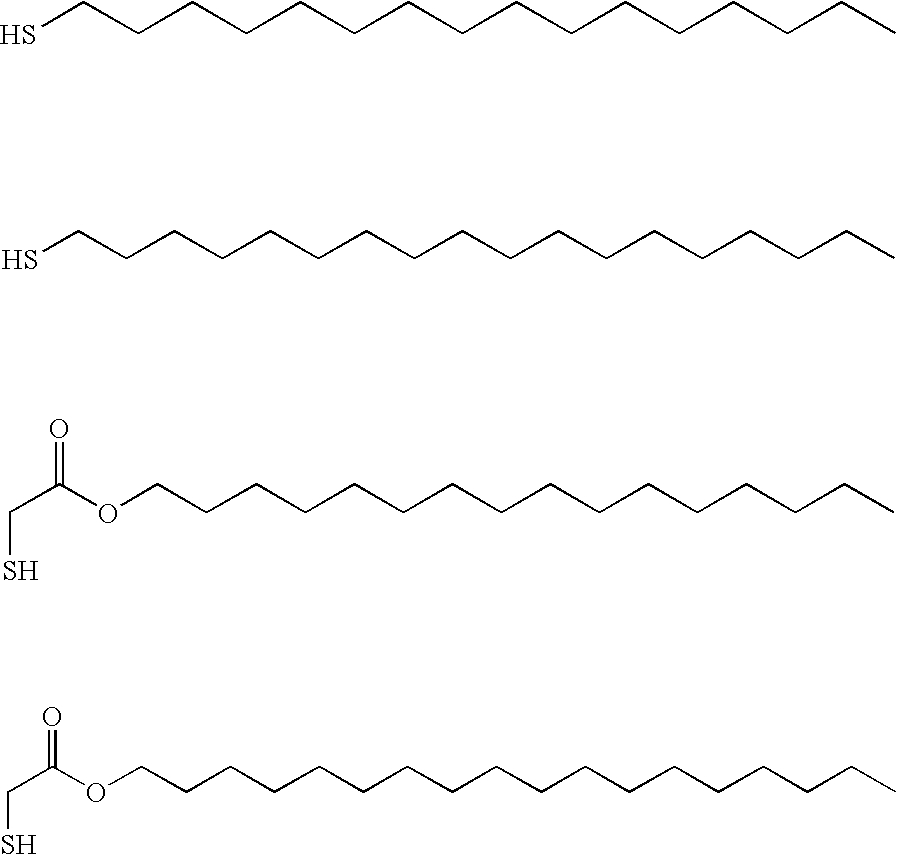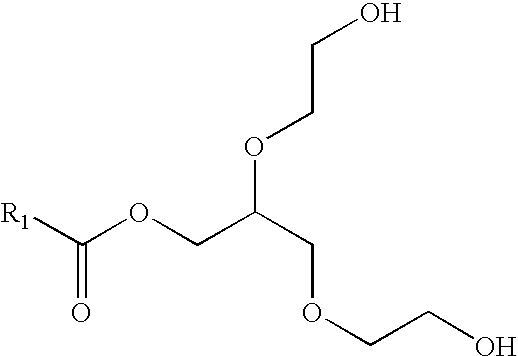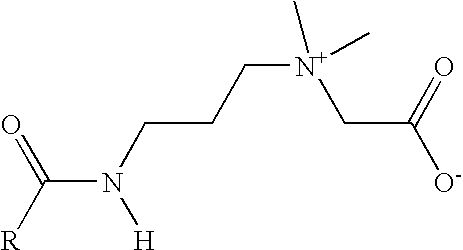Water-Based Metal Treatment Composition
a technology of metal treatment and composition, applied in the direction of detergent compounding agent, soldering apparatus, manufacturing tools, etc., can solve the problems of tarnish appreciably delayed, difficulty in soldering, and addition of prone to cracking of alloy
- Summary
- Abstract
- Description
- Claims
- Application Information
AI Technical Summary
Benefits of technology
Problems solved by technology
Method used
Image
Examples
example 1
Hexadecyl Mercaptan in Fairy Liquid
[0078] Hexadecyl mercaptan (1 g) in the liquid state was mixed with Fairy liquid (surfactant containing anionic and nonionic surface active agents) and with water in the quantities indicated below:
ReferenceFairy liquid (ml)Deionised water (ml)1.140Nil1.2100Nil1.3200Nil1.4401001.540200
[0079] The ingredients of solution 1.2 appeared to mix well without needing the hexadecyl mercaptan to be dissolved in an organic solvent beforehand. A sample of Argentium silver was immersed in the resulting solution for 10 minutes and rinsed. The surface of the Argentium sample had become hydrophobic, suggesting the formation of a layer of hexadecyl mercaptan attached to the surface of the Argentium silver. It rinsed well in water without any noticeable deposit being left on the surface after rinsing.
[0080] A region of the sample was rubbed with cotton wool soaked in EnSolv 765 and then subjected to tarnish testing with neat ammonium polysulphide over a period of...
example 2
Hexadecyl Mercaptan in Simple Shower Gel
[0081] Simple shower gel, a clear shower gel, was obtained from Accentia Health and Beauty Ltd, Birmingham, UK It contains sodium laureth sulfate (10.0%), cocamidopropyl betaine (2.8%), coconut fatty acid diethanolamide (1.8%), sodium chloride (0.95%) and glycerin the balance being water. Analysis was by drying the shower gel on a steam-bath under a steady stream of nitrogen followed by vacuum oven treatment. The dried sample was dissolved in deuterated methanol and analysed by proton NMR. The proton NMR was compared with the spectra of known samples of sodium laureth sulfate, cocamidopropyl betaine and coconut fatty acid diethanolamide, and the ratio of these ingredients was estimated. The salt content of the gel was determined using a Corning chloride analyser 926 and sodium content was determined by atomic absorption spectroscopy.
[0082] The gel was mixed with liquid hexadecyl mercaptan and with water in the quantities indicated below:
Re...
example 3
Mixtures of Cocamidopropyl Betaine (CPB) and Sodium Laureth Sulfate (SLS)
[0086] The above materials were supplied as a thick pourable aqueous liquid and as a highly concentrated somewhat gelatinous liquid (70% active) by Surfachem Ltd of Leeds, United Kindgom. Hexadecyl mercaptan (1 ml) in the liquid state was mixed with these materials in the quantities indicated below:
ReferenceSLS (ml)CPB (ml)Water (ml)3.140401003.240201003.330101003.41030503.53010160
[0087] For solution 3.1, hexadecyl mercaptan was added to a thick mixture of sodium laureth sulphate and cocarnidopropyl betaine after which water was added and the solution was mixed cold. The resulting mixture initially had a thick foamy-white texture and on settling turned into a transparent gel. Solution 3.2 was somewhat similar. Solution 3.3 was watery and was initially slightly transparent with lots of bubbles on top of the solution, and on settling overnight it became transparent. Solution 3.4 was mixed with gentle heating t...
PUM
| Property | Measurement | Unit |
|---|---|---|
| Volume | aaaaa | aaaaa |
| Volume | aaaaa | aaaaa |
| Volume | aaaaa | aaaaa |
Abstract
Description
Claims
Application Information
 Login to View More
Login to View More - R&D
- Intellectual Property
- Life Sciences
- Materials
- Tech Scout
- Unparalleled Data Quality
- Higher Quality Content
- 60% Fewer Hallucinations
Browse by: Latest US Patents, China's latest patents, Technical Efficacy Thesaurus, Application Domain, Technology Topic, Popular Technical Reports.
© 2025 PatSnap. All rights reserved.Legal|Privacy policy|Modern Slavery Act Transparency Statement|Sitemap|About US| Contact US: help@patsnap.com



